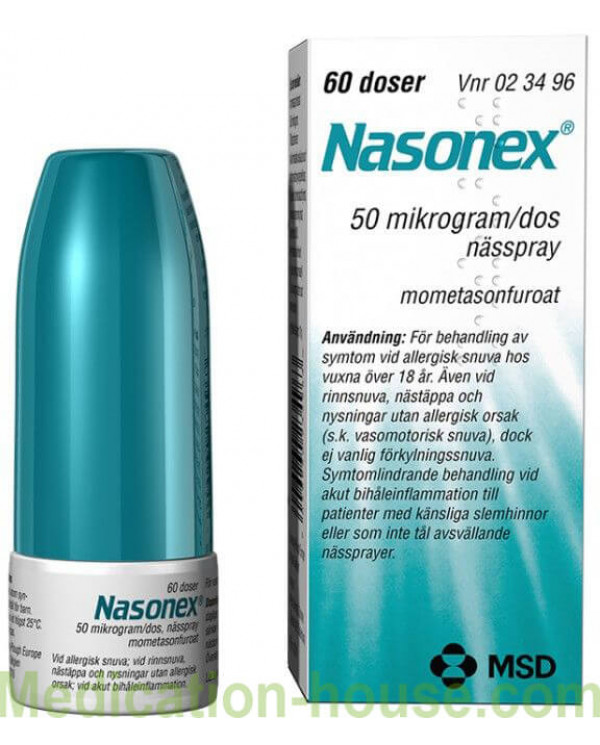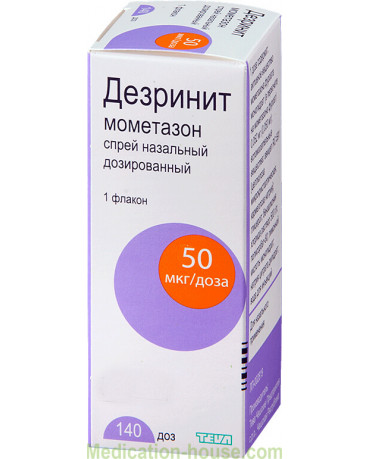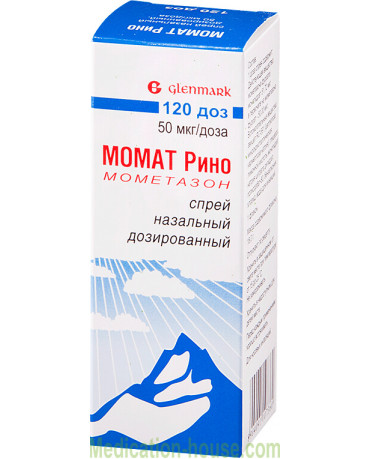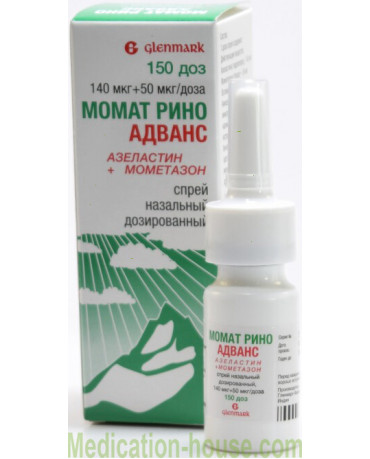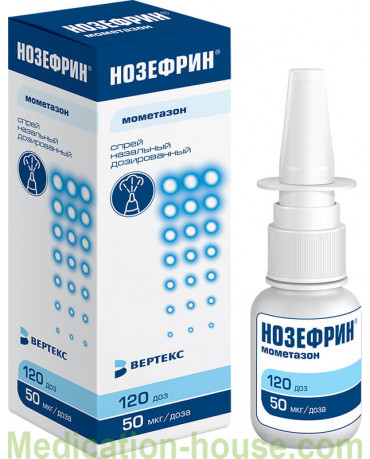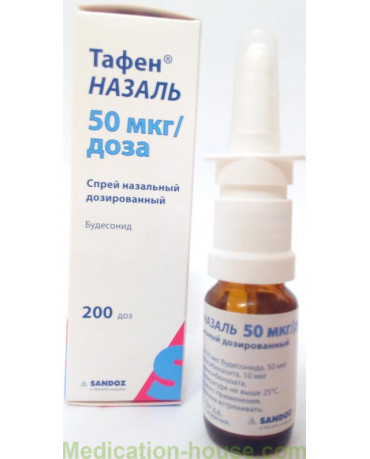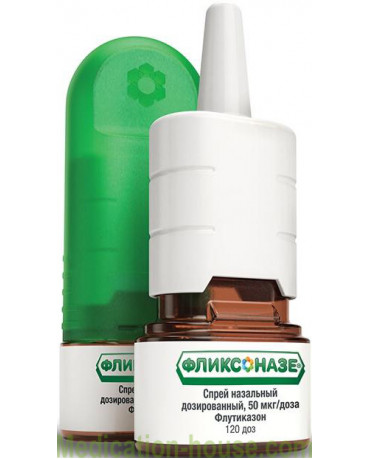Nasonex instruction
You can buy Nasonex here
The main element of the drug is a substance such as monetazone furoate, which has an anti-inflammatory effect and eliminates the manifestations of an allergic nature.
The popularity of the spray for antritis and other complications of allergic rhinitis is due to its high efficiency and mild action, combined with good tolerability and the practical absence of serious side effects.
Release form and composition
Nasonex is released in the form of a nasal spray dose of 0.05 mg / 1 dose: almost white or white suspension (in polyethylene bottles with a metering valve of 10 or 18 g each with a safety cap; 1 bottle in a carton box).
1 spray dose contains:
Active ingredient: mometasone furoate (micronized, in the form of monohydrate) - 0.05 mg;
Auxiliary components: benzalkonium chloride (as a 50% solution), citric acid monohydrate, purified water, polysorbate 80, sodium citrate dihydrate, glycerol, microcrystalline cellulose, treated with carmellose sodium (dispersed cellulose).
Pharmacological effect
Nasonex - GKS local action. Carries antiallergic and anti-inflammatory effect, reduces the production of inflammatory mediators. Prevents marginal accumulations of neutrophils, which reduces the amount of inflammatory exudate, reduces the processes of infiltration and granulation.
Systemic bioavailability of Nasonex is low, the active substance is not detected in the plasma, even when using sensitive methods of determination. Minimum doses of mometasone can enter the gastrointestinal tract and are excreted with the participation of the liver.
Indications for use
According to the instructions for use allocate the following indications for the use of Nasonex:
treatment of seasonal and year-round rhinitis in adults, children older than two years;
treatment of adenoids in children;
seasonal exacerbation of sinusitis (complex antibiotic treatment is used) in adults, including seniors, and children over 12 years old;
prevention of seasonal allergic rhinitis, occurring in the medium and severe stages (2-4 weeks before the dusting season).
Contraindications
Contraindications to the appointment of Nasonex are:
intolerance to any of its components;
active or latent tuberculous infection of the respiratory tract;
the presence of an untreated / undertreated local infection, provided that the nasal mucosa is involved in the process;
untreated bacterial, systemic viral or mycotic infection, as well as infection caused by the herpes simplex virus with eye damage (in some cases, the drug may be prescribed as an exception as directed by the attending physician).
If the patient in the recent past suffered a nose injury or nose surgery, the use of a spray is contraindicated until the wound heals.
Use during pregnancy and lactation
Nasonex during pregnancy is not contraindicated for the purpose, but is rarely used because of the lack of statistically reliable data on its safety for the health of the mother and fetus.
Provided that the doctor still recommends treatment with Nasonex for a woman during pregnancy (it is usually difficult to replace the drug for allergic nature of the allergic nature), it is necessary to thoroughly examine the child after giving birth to exclude congenital adrenal hypofunction.
If allergic rhinitis is seasonal in nature, it is not recommended to prescribe a drug for prophylactic purposes: for this, it is better to choose a hormone-free medicine from an impressive arsenal of currently existing drugs. The same applies to mothers who are breastfeeding.
Dosage and method of use
The instructions for use indicate that Nasonex is intended for intranasal use.
1 dose = 1 injection and contains 50 µg of mometasone.
Treatment of seasonal or year-round allergic rhinitis:
Children 2–11 years old: the recommended therapeutic dose is 1 injection in each nostril 1 time per day. Young children with the introduction of the drug is required by adults.
Adolescents from 12 years old and adults (including the elderly): the recommended therapeutic and prophylactic dose - 2 injections into each nasal passage 1 time per day, after reaching the required therapeutic effect for maintenance therapy, the dose can be reduced to 1 injection per each nostril 1 time per day. If, however, it was not possible to reduce the symptoms, the daily dose can be increased to 4 Nasonex injections in each nasal passage. After improvement, the dose should be reduced.
The onset of action of Nasonex occurs as standard 12 hours after the first dose.
In acute sinusitis and exacerbation of chronic sinusitis, adults and adolescents from 12 years old Nasonex is usually prescribed 2 injections in each nasal passage 2 times a day. If improvement does not occur, it is possible to increase the daily dose to 4 injections in each nostril 2 times a day. After reducing the severity of symptoms, the dose should be reduced.
For the treatment of acute rhinosinusitis (provided there are no signs of severe bacterial infection), adolescents from 12 years of age and adults require the use of Nasonex, 2 doses in each nasal passage 2 times a day. If the condition worsens, consult a physician.
In case of polyposis, adults, including elderly patients, are prescribed 2 injections in each nostril 2 times a day. As soon as the severity of symptoms of the disease decreases, it is recommended to reduce the dose to 2 injections in each nasal passage 1 time per day.
Terms of use of the drug Nasonex
The introduction of the spray is carried out using a special dispensing nozzle on the bottle.
Before the first use of the Nasonex nasal spray, it is necessary to calibrate by pressing the dosing device 10 times, until a spray appears, indicating that the preparation is ready for use.
You should tilt your head and inject the drug into each nostril as recommended by the attending physician.
If the nasal spray has not been used for 14 days or longer, you need to press the dispensing tip 2 times until a spray appears.
Before each use, shake the bottle vigorously.
To prevent the dosing nozzle from malfunctioning, it should be cleaned regularly as follows:
Remove the protective cap first, then the spray tip.
Rinse them in warm water and rinse well under running water.
Dry in a warm place.
Attach the tip to the vial.
Tighten the protective cap.
The first time you use Nasonex after cleaning the nozzle, you need to calibrate - 2 times press the dosing nozzle.
Do not attempt to open the nasal applicator with a needle or other sharp object, since this will damage the applicator, resulting in an incorrect dose of the drug.
Side effects
The most likely side effects are:
sneezing (short term);
irritation of the mucous membrane of the nasopharynx;
headaches;
nasal bleeding of medium intensity, which pass quickly and do not require medical care;
inflammation of the mucous membrane - pharyngitis (occurs with prolonged use of the drug);
burning, itching, unpleasant pain in the nasal passages (appear immediately after instillation, when the substance falls on the mucous membrane, and pass away for a short time).
Unlikely side effects
pains in muscles and joints;
the appearance of cataracts or glaucoma;
increased intraocular pressure;
fatigue, lethargy, depression;
adrenal dysfunction;
Cushing's syndrome (chronic oversupply of glucocorticoids, which is manifested by weight gain, changes in skin condition, excessive hairiness in women, mental changes, and other symptoms).
Overdose
Due to the fact that the systemic bioavailability of the drug Nasonex is <1% (when using the method of quantitative determination with a threshold of sensitivity (LLOQ) of 0.25 pg / ml), it is unlikely that overdose will require other measures, except for monitoring the patient's condition with subsequent use drug in the recommended dose.
special instructions
As with any long-term treatment, patients using Nasonex nasal spray for several months or longer should be examined periodically by a doctor for possible changes in the nasal mucosa. It is necessary to monitor patients receiving intranasal GCS for a long time. Perhaps the development of growth retardation in children. In case of detection of growth retardation in children, it is necessary to reduce the dose of intranasal GCS to the lowest, allowing to effectively control symptoms. In addition, the patient should be referred for consultation to the pediatrician.
When conducting placebo-controlled clinical trials in children, when Nasonex nasal spray was used in a daily dose of 100 mcg for a year, growth was not observed in children.
If a local nasal or pharynx fungal infection develops, it may be necessary to discontinue Nasonex nasal spray therapy and perform special treatment. Prolonged irritation of the nasal and pharyngeal mucous membranes can also serve as a basis for discontinuing the Nasonex nasal spray treatment.
With the use of intranasal corticosteroids, the development of systemic side effects is possible, especially with prolonged use in high doses. The likelihood of these effects is significantly less than with the use of oral corticosteroids. Systemic side effects can vary both in individual patients, and depending on the used GCS. Potential systemic effects include Cushing's syndrome, the characteristic signs of cushingoid, suppression of adrenal function, growth retardation in children and adolescents, cataracts, glaucoma, and more rarely a number of psychological or behavioral effects, including psychomotor hyperactivity, sleep disturbance, anxiety, depression, or aggression (especially children).
With prolonged treatment with a nasonex nasal spray, signs of suppression of the function of the hypothalamic-pituitary-adrenal system were not observed. Patients who go on to treatment with Nasonex nasal spray after long-term treatment of systemic corticosteroids require special attention. Cancellation of the GCS of a systemic effect in such patients may lead to an insufficiency of the adrenal function, the subsequent recovery of which can take up to several months. In case of signs of adrenal insufficiency, you should resume taking systemic corticosteroids and take other necessary measures.
Patients who are treated with GCS have potentially reduced immune reactivity and should be warned about their increased risk of infection if they come into contact with patients with certain infectious diseases (for example, chickenpox, measles), and the need for medical advice if such contact occurs. . If signs of severe bacterial infection appear (for example, fever, persistent and sharp pain on one side of the face or toothache, swelling in the orbital or periorbital region), immediate medical consultation is required.
During the transition from treatment of systemic corticosteroids to nasal nasal spray treatment, some patients may experience initial withdrawal symptoms of systemic corticosteroids (for example, pain in the joints and / or muscles, fatigue and depression), despite a decrease in the severity of symptoms associated with mucosal lesions shell of the nose. Such patients need to be specifically convinced of the advisability of continuing treatment with Nasonex nasal spray. The transition from systemic to local corticosteroids can also reveal pre-existing, but masked, therapy of corticosteroids of systemic action, allergic diseases, such as allergic conjunctivitis and eczema.
The efficacy and safety of mometasone has not been studied in the treatment of unilateral polyps, polyps associated with cystic fibrosis and polyps that completely cover the nasal cavity.
When using the nasal spray Nasonex for 12 months there were no signs of atrophy of the nasal mucosa. In addition, mometasone furoate showed a tendency to contribute to the normalization of the histological pattern in the study of nasal mucosa biopsies.
In the case of unilateral polyps of unusual or irregular shape, especially ulcerated or bleeding, it is necessary to conduct additional medical examination.
Drug interactions
Combination therapy with loratadine was well tolerated by patients. However, no effect of the drug on the concentration of loratadine or its main metabolite in the blood plasma was noted. In these studies, mometasone furoate was not detected in the blood plasma (with a sensitivity of the method of determination of 50 pg / ml).
Reviews
We picked up some reviews of people using the drug Nasonex:
Svetlana
My son at the age of three suddenly began to appear regularly allergic rhinitis. We were immediately prescribed Nasonex, because without hormonal drugs, severe swelling could not be removed. Of course, the drug is not completely safe, because there are hormones, corticosteroids. But when applied topically, they are almost not absorbed into the bloodstream, and we didn’t have any side effects with course irrigation of the nose. It is very convenient that you need to use Nasonex spray only once a day, before going to bed. It is a pity that it costs so much, but we haven’t found any analogues for ourselves, only this medicine allows the son to breathe calmly with his nose during an exacerbation of allergies.
Alice
The doctor prescribed Nasonex for 4.5 years, 1 pc in each nostril once a day for 10 days, I had to leave due to circumstances, and my grandmother remained to treat her son, and instead of once a day she pshikat three times a day, he was prescribed syrupret syrup and antiallergic drops, grandmother bit confused and gave drops 1 time a day and sprayed three times a day, they told Laura how to eat, said that she should be attentive in the future, but once she’s done, it's okay, it’s not absorbed into the blood but acts locally , though lor and reassured, but I like put that instead of a dose the child received a triple dose of a harmonious preparation, and even 10 days, Ash hair stand on end !!!! Maybe someone had this, tell me what's next, or since the ENT and said that there is nothing particularly terrible?
Vladimir
I suffer from seasonal rhinitis for the second year. When birches are blooming, it is impossible to be in the city. Saves only Nasonex, who prescribed a doctor. I like that in one application per day I forget about the stuffy nose for the whole day. You can safely walk and not suffer from sneezing, red eyes and laryngeal edema, which used to be painful for me.
Storage conditions and shelf life
An opened vial should be kept out of the reach of children, preferably in a refrigerator. Do not heat or freeze the drug.
Nasonex can be stored for 2 years from the date of manufacture of the medicine indicated on the package. At the end of this period, the spray can not be applied.
Terms of sell
You don't need a prescription to buy Nasonex spray.

